The Roseline Shark or Denison barb makes a beautiful addition to a large community setup. These fish are colorful, active, and sociable, and they make a gorgeous display when kept in a group.
In the wild, Roseline Sharks are regarded as endangered on the IUCN Red List, thanks to the fish’s decreasing numbers, and they’re not the easiest fish to keep in the home aquarium.
That said, if you’re up for a challenge, read this detailed guide to find out everything you need to know about caring for the Roseline Shark.
Roseline Shark – Overview
Scientific Name
Sahyadria denisonii
Common Name (species)
Roseline Shark, Denison barb, Red-Line Torpedo barb, Miss Kerala
Family
Origin
Weston Ghats, India, specifically the Achankovil River, Cheenkannipuzha (a major tributary of Valapattanam River), near Mundakayam town, and in the Chaliyar River
Diet
Omnivore
Care Level
Intermediate
Activity
Active, peaceful shoaling species
Lifespan
Up to 5 years
Temperament
Peaceful
Tank Level
All areas but predominantly midwater
Minimum Tank Size
55 gallons
Temperature Range
Tropical 60° to 77° Fahrenheit
Water Hardness
5 – 25 dGH
pH Range
6.8 to 7.8
Filtration/Flow Rate
Needs highly-oxygenated, pristine water and a high flow rate
Water type
Freshwater
Breeding
Egg layer, rarely achieved in home aquariums
Compatibility
Peaceful. Gets along with most other non-aggressive freshwater fish species
OK for Planted Tanks?
Safe with plants
Origins
The Roseline Shark was first described in 1865 and is found in only four locations in Weston Ghats, India, specifically the Achankovil River, Cheenkannipuzha (a major tributary of Valapattanam River), near Mundakayam town, and in the Chaliyar River.
Unfortunately, the species’ popularity in the hobby led to overfishing, and that, together with local deforestation, decimated the wild population of Denison barbs. For that reason, the fish are now considered endangered, and their populations are regarded as “decreasing” on the IUCN Red List.
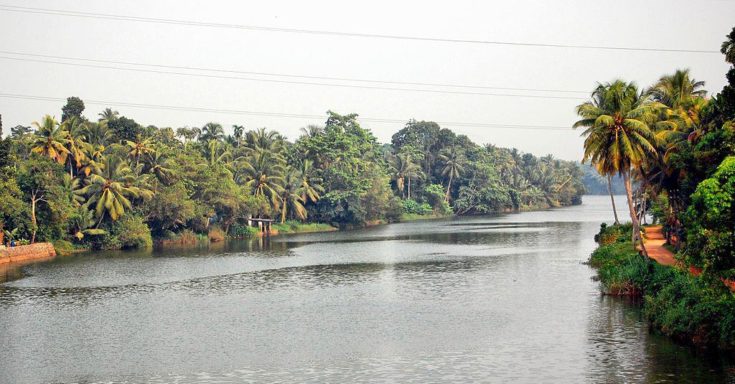
Fortunately, there are now commercial fish breeding programs in Eastern Europe and Southeast Asia, and wild-collection of the Roseline Shark is greatly restricted.
Natural Habitat
Roseline Sharks live in large shoals, inhabiting streams, rivers, and pools where the water is clear and highly-oxygenated.
The environment in these areas is rocky and densely vegetated with a relatively high flow rate.
Appearance
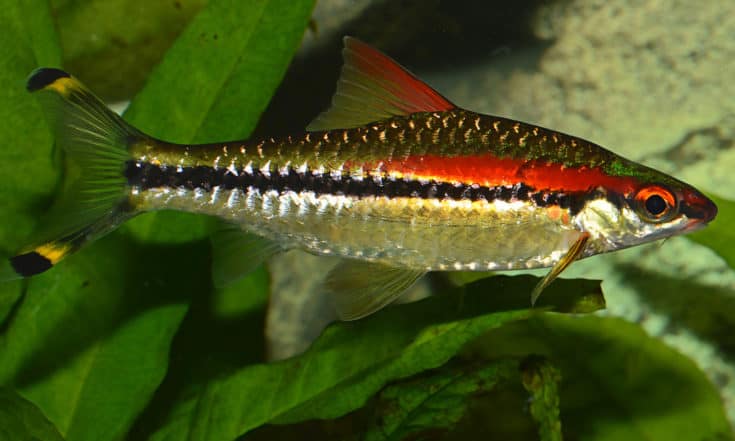
Denison barbs are long, torpedo-shaped fish. The body is silvery with a black line that extends for the whole length of the fish from snout to tail. In contrast, there’s a bright scarlet line that runs along the top of the fish’s black line, from its snout, through the eye, and along the body to the midpoint.
The dorsal fin is edged with brilliant red, and the caudal fin has bright yellow and black stripes. When mature, some specimens develop a green tinge on the head. You can also buy an artificially created gold variant that has the red line but not the black stripe.
Size
A full-grown Roseline Shark measures around 6 inches in length.
Life Expectancy
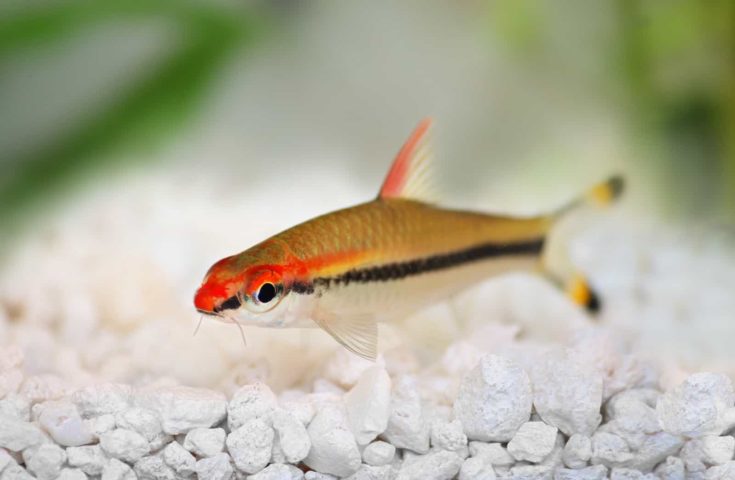
Roseline Sharks live for up to five years in captivity, as long as you provide a high-quality diet and pristine water conditions.
Activity Level/Temperament
Although the Roseline Shark is a peaceful fish, they are extremely active, darting around the tank in a beautiful, sparkling school.
However, it should be noted that there have been reports of aggression in specimens that are kept in very small aquariums, so you must provide plenty of space for them.
Compatibility and Tankmates
Roseline barbs do not do well when kept in isolation or in pairs, as they rely on social interaction to remain stress-free and healthy.
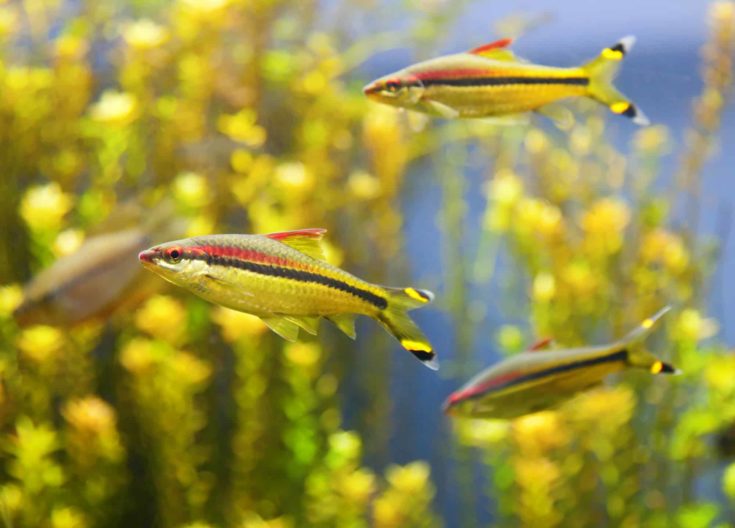
For that reason, I recommend that you keep a school of at least six Denison barbs.
Tank Mates
In addition to their own kind, there are quite a few other fish species that generally do well with Roseline barbs. Basically, you want fish that are agile and fast swimmers, and which don’t have trailing, delicate fins.
A few ideas for tank mates include:
- Large tetra species
- Cherry barb
- Rosy barb
- Celestial Pearl danio
- Tiger barb
- Rainbow fish
- Kribensis cichlids
- Corydoras catfish
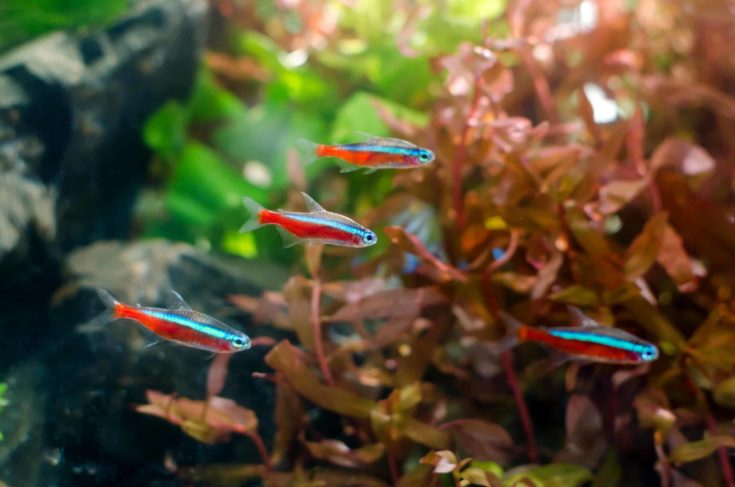
It’s recommended that you don’t keep slow-swimming fish, which could be injured or stressed by the speedy Denison barbs.
Feeding
To keep your Sharks in tip-top condition, always feed them the highest quality food that you can get. Cheap brands of fish food generally contain lots of padding, which has no nutritional value and can cause long-term digestive health problems.
What to Feed Your Roseline Shark
Roseline Sharks are omnivorous, so they need a diet of both meaty protein and vegetable matter.
In nature, these fish consume insects, small invertebrates, some plant matter, and algae. You can feed your Denison barbs tropical fish flakes and pellets as a basic diet, choosing a high-quality food containing carotenoids to boost the fish’ color.
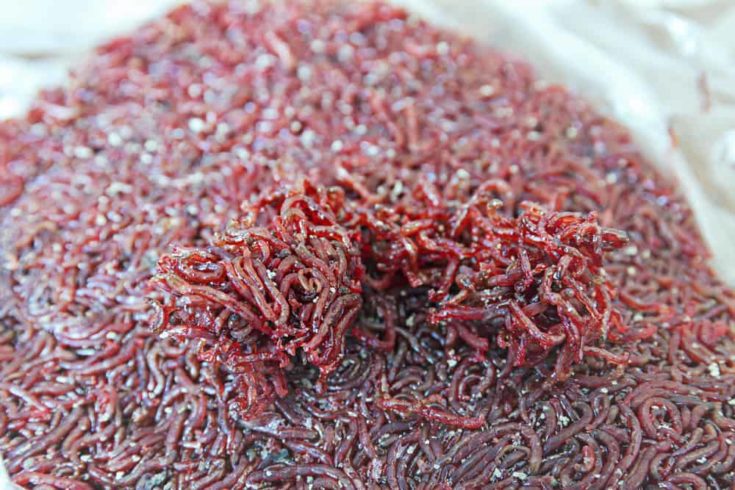
Add variety to the diet and add live and frozen foods, especially daphnia, bloodworms, brine shrimp, and spirulina. These fish also appreciate a few blanched vegetables as a treat.
How Much and How Often to Feed
Feed your fish twice a day, only offering what they will consume in a couple of minutes.
Tank Requirements
Tank size
Roseline Sharks grow to around 6 inches in length as adults, and they are powerful, active swimmers that need plenty of space.
The minimum aquarium size that I recommend is 55 gallons for a small school of fish, larger if you want to create a mixed-species community setup.
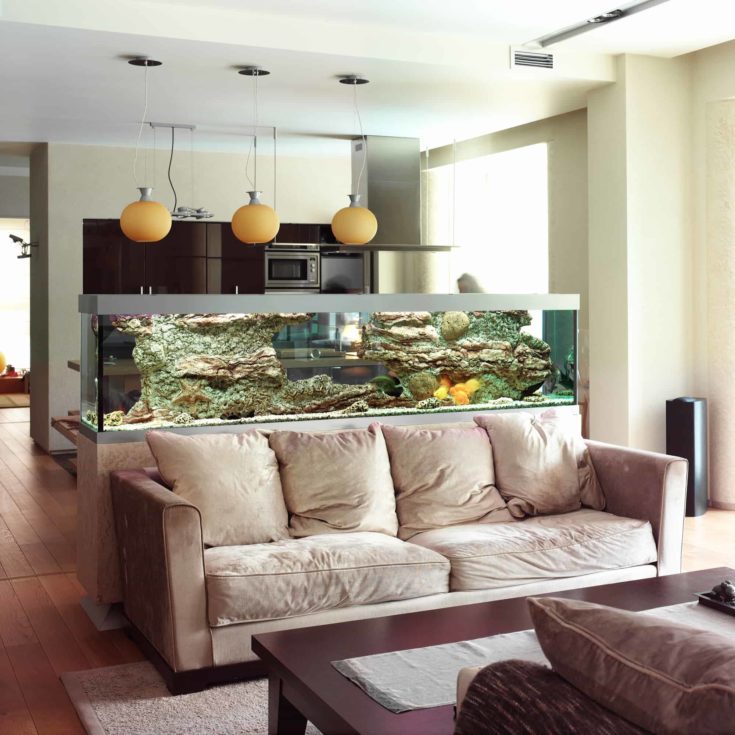
The tank should ideally be rectangular to maximize swimming space, and you’ll need a cover slide or tight-fitting lid, as these fish can jump!
Tank Setup
Substrate
Choose fine gravel or coarse sand as a substrate in your Roseline Sharks’ tank.
Decoration
It’s important to replicate the Denison barb’s natural habitat when choosing decorations for the interior of the tank. That helps to relax the fish, prevents stress, and encourages the barbs to develop their vibrant colors.
Add rocks, smooth stones, and pebbles for a natural look, but remember that these fish do need lots of space to swim, so don’t clutter the tank too much. That said, the Sharks do appreciate a few hiding places, so you can include caves, overhangs, and a few twisted roots.
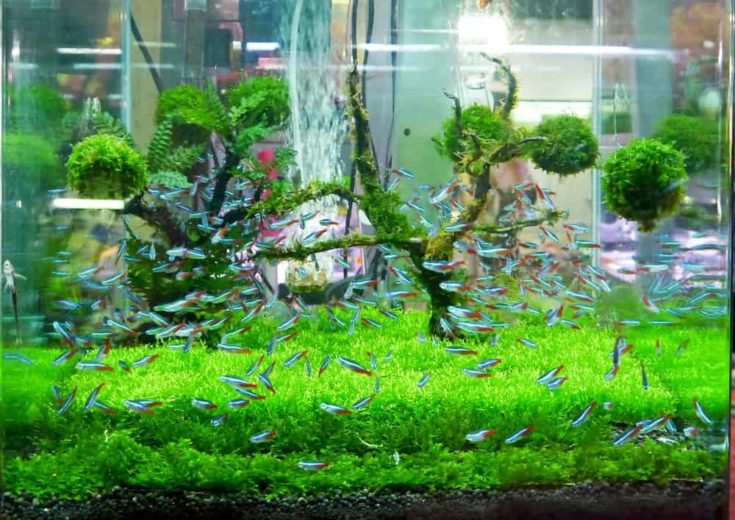
Dense planting is very important, but you must be sure to anchor your plants securely so that they don’t get uprooted by the fish, dashing through and around the stems.
Habitat Requirements
Filtration
Roseline Sharks need a fast flow and extremely well-oxygenated water. The tank’s water should be pristine, so we recommend that you use an external canister filter and a powerhead.
Water Parameters
Water Temperature
Roseline Sharks are tropical fish that require a water temperature of between 60° and 77° F.
Water Hardness and pH Range
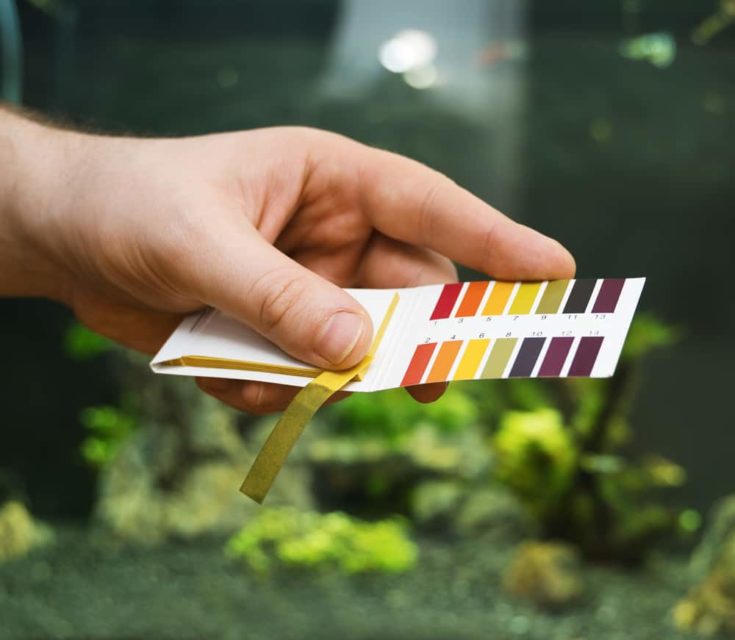
Your tank water should have a pH in the range of 6.6 to 7.8, with a water hardness of 5 to 25 dKH.
Lighting
Roseline Sharks are happy with normal lighting conditions, so choose an LED lighting rig that best suits whatever plant species you decide to go with.
Tank Maintenance
Roseline Sharks need pristine water conditions, so they don’t suit lazy fish keepers!
You’ll need to carry out a 30% to 35% water change every week, as well as vacuuming the substrate, tank corners, underneath decorations, and around the base of plant stems. That’s crucial, as you want to remove uneaten fish food, plant debris, and fish waste, which would otherwise pollute the water.
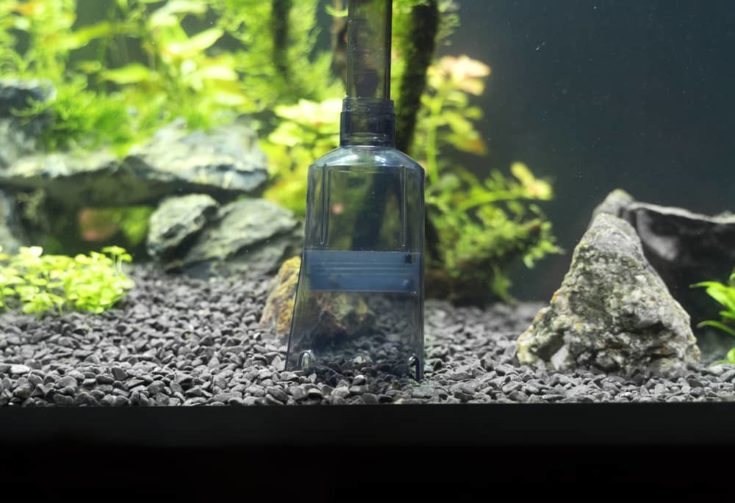
Remember to rinse your filter media and change it when required, as per the manufacturer’s guidelines.
Setting Up the Aquarium
When setting up your fish tank, start by assembling what you need, including:
- Sand or fine gravel substrate
- LED lighting unit
- Canister filtration system
- Powerhead
- Heater
- Aquarium thermometer
- Decorations, including driftwood, smooth stones, and caves
- Plants
How to Set up Your Aquarium
- Rinse the substrate under running water to make sure it’s clean.
- Place two to three inches of sand or gravel into your tank, and set an upturned bowl on the top of the substrate.
- Install the filtration unit and heater in the tank, but don’t turn them on.
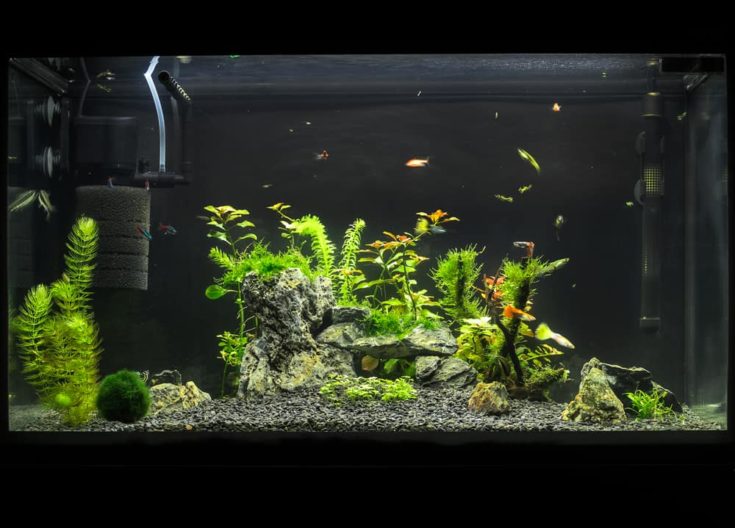
- Now, fill the aquarium with tap water that’s been treated with a water conditioner to get rid of any harmful chemicals. Empty the water into your tank, pouring it over the bowl to avoid displacing the substrate.
- You need the water to contain a small quantity of ammonia to start the nitrogen cycle in your biological filter. To do that, “seed” the water by adding some gravel from a mature tank, a pinch or two of fish food, or a few drops of pure ammonia.
- Rinse your tank décor to remove dust, and place everything in the tank.
- Tidy up your plants by removing damaged or dead stems and leaves. Make sure that there’s enough space between the plants to allow them to grow and spread.
- Switch on the heater and filter. Turn on the aquarium lighting for eight to ten hours a day if you’re using live plants.
- Wait for at least ten days before you add fish to the aquarium so that the tank can cycle fully. Before you introduce your Roseline Sharks, test the water. Levels of ammonia and nitrites must be zero, and nitrate levels should be at a maximum of 20ppm. You may need to allow a few more days if the levels are too high.
Health and Disease
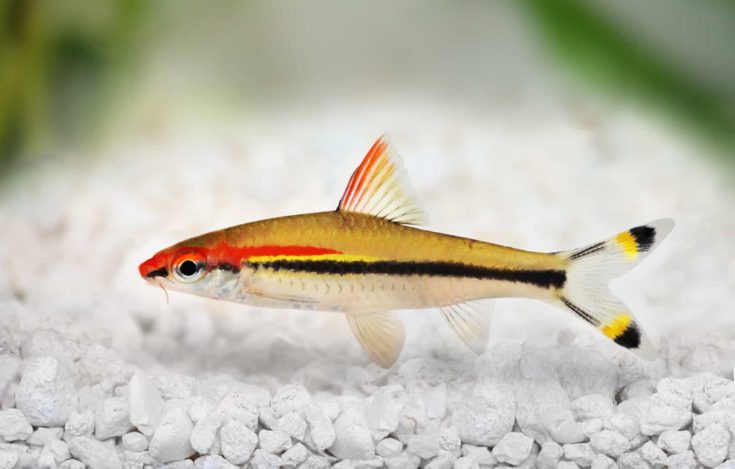
Roseline Sharks are generally healthy and hardy, but you must give them pristine, crystal clear water. If the water is dirty or unsanitary, the fish will become stressed, leaving them prone to common fish diseases.
Signs of Good Health
Denison barbs are extremely active, lively, shoaling fish that love to swim in the tank’s open areas. They are curious fish that like to explore their environment.
Red Flags
There are some red flags to be aware of, including:
- Poor appetite
- Lethargy
- Not swimming as part of the school
- Swellings, ulcers, and red patches on the skin
- Rubbing against tank décor or flicking against the substrate
Common Health Issues and Treatment
Health Issue
Ich (White Spot Disease)
Symptoms or Causes
Ich is a very common disease that’s caused by an aquatic protozoan parasite.
Fish infected with Ich develop a sprinkling of tiny white spots on their fins, gill covers, and bodies. They also flash against the gravel and other solid objects in the aquarium.
Suggested Action
Raise the water temperature to 82o F for three days. Use an OTC White Spot Disease medication to treat the tank.
Health Issue
Skin and gill flukes
Symptoms or Causes
Flukes are parasitic creatures that fasten themselves to the fish’s gills or body. Affected fish rub against the substrate and ornaments and secrete excessive mucus
Suggested Action
Quarantine any affected fish, and treat the water with antifungal treatment.
Health Issue
Fungal infections
Symptoms or Causes
White cottony growths.
Suggested Action
Quarantine infected fish, and treat with an antifungal medication.
Health Issue
Bacterial infections
Symptoms or Causes
Red areas on the skin, sores, ulcers.
Suggested Action
Treat the tank with antibacterial medication.
Breeding
Roseline Sharks cannot be bred successfully in the home aquarium. The specimens you buy in fish stores or online are generally raised by commercial breeders who use hormones to encourage spawning.
I don’t recommend that you attempt to breed the fish in your tank, as that can cause them stress and is most likely to fail anyway.
Availability
You can sometimes buy Roseline Sharks in fish stores, but you’re most likely to find them for sale via online dealers and fish shops starting at around $20 per fish.
Product Recommendations
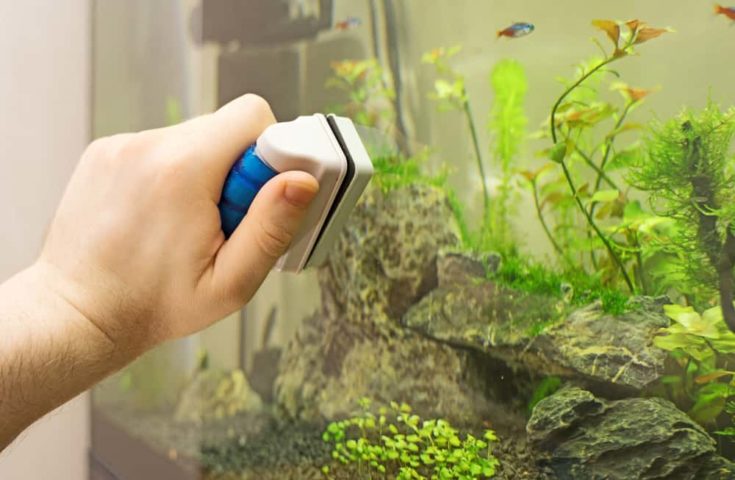
- A fishnet
- Algae magnet
- Aquarium thermometer
- Aquarium vacuum
- Books on keeping tropical fish
- Filtration system
- Fish tank (minimum size 55 gallons)
- Heater
- High-quality tropical fish flakes and pellets
- LED lighting unit
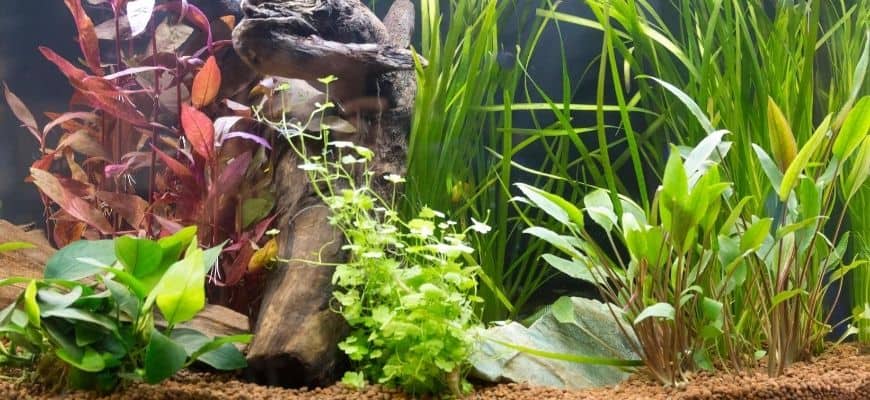
- Plants
- Rocks, driftwood, twisted roots, caves
- Sand or fine gravel substrate
- Selection of frozen foods
- Water conditioner
In Conclusion
I hope you enjoyed our guide to caring for the Roseline Shark.
Do you have Roseline Sharks in your setup? Tell us about them in the comments box below!
And don’t forget to share our guide if you enjoyed it!
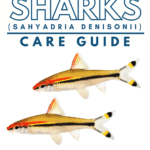
I have 3 roselines in my 55 gallon tank.i have lots of live plants many different varietys.i have various large rocks studded with plants as well.in the left hand side corner I have bubble action going on both sides.all my fish seem to really enjoy it.i have a variety of fish and all seem to get along well.i plan toreturn to the fish shop and buy 3 more.i have schools of emerald eye tetras and rummy nose to .i.enjoy seeing.schools of fish.they are all healthy..I feed them a diet of pellets and wafers tetra min and colorflake
tetramin food I give the freeze dried shrimp fresh frozen shrimp fresh frozen blood worms, also freeze dried worms as well .once in a while I drop microbial solutions in the water just to heal and bacteria that are harmful as well as a parasitical solution as well.im running two topside filters at this time. Every fish in the tank get along well.lots of oxygen from plants and bubble action .my cat Lilac and I enjoy watching them swim around they are nice to look at.imooking forward to buying 3 more.